
Guests
- Gary Dorrmedia and logistical coordinator for the Rosebud Sioux Tribe’s “Shield the People” project, an effort to oppose the Keystone XL pipeline. He is a member of the Nez Perce Nation and was one of the organizers of the Reject and Protect encampment in D.C. last week.
- Art TanderupNebraska farmer who has been protesting the proposed Keystone XL pipeline. He was in Washington, D.C., last week for the Reject and Protect protest. He owns the land where the crop circle protest art was drawn. He is also a member of the Cowboy Indian Alliance.
- Daryl Hannahan actress and activist. She has been arrested multiple times in protests opposing the Keystone XL pipeline.
Thousands of people rallied in Washington, D.C., on Saturday calling on President Obama to reject the Keystone XL pipeline. The protest was organized by the Cowboy Indian Alliance, a group of ranchers, farmers and tribal communities from along the pipeline route who have set up the “Reject and Protect” encampment near the White House. The rally came a week after the Obama administration announced it had again delayed a decision on approval or rejection of the pipeline that would carry tar sands oil from Alberta to the Gulf Coast. To discuss the continued resistance to the pipeline, we are joined by three guests: Gary Dorr of the Nez Perce Nation, an organizer of the Reject and Protect encampment; Art Tanderup, a Nebraska farmer and Cowboy Indian Alliance member who took part in the protest; and Daryl Hannah, an actress and activist who has been arrested three times for protests against the Keystone XL.
Transcript
AMY GOODMAN: Thousands of people rallied in Washington, D.C., on Saturday calling on President Obama to reject the Keystone XL pipeline. The rally came four days after Earth Day, when a group of ranchers, farmers and tribal communities from along the pipeline route rode into Washington, D.C., and set up the Reject and Protect encampment near the White House. The group called themselves the Cowboy Indian Alliance.
During Saturday’s procession, members of the alliance presented a hand-painted teepee to the Smithsonian National Museum of the American Indian as a gift to President Obama. The teepee represented the Cowboy and Indian Alliance’s hopes for protected land and clean water. Legendary musician Neil Young joined the protesters who rallied on the National Mall, then marched past the Capitol building.
NEIL YOUNG: We’re all children of Mother Earth, and that’s why I’m here, because I feel we’re all threatened by what’s happening. As a planet, we’re threatened. I feel that the fossil fuel age is ending. It’s having its first death gasps. And we need to keep pushing. We need to stop this pipeline, which is bringing this really bad fuel from Canada, from the tail of the snake, all the way down to the head of the snake in Texas.
AMY GOODMAN: Saturday’s rally came a week after the Obama administration announced it had again delayed a decision on approval or rejection of the Keystone XL pipeline that would carry tar sands oil from Alberta to the Gulf Coast. The State Department says it will await the results of legal challenges to the pipeline’s proposed route through Nebraska. That means a final move would not likely come until after the midterm elections.
To talk more about the protests and the pipeline, we’re joined by three guests. In Washington, D.C., Gary Dorr is with us. He is the media and logistical coordinator for the Rosebud Sioux Tribe’s Shield the People project, an effort to defend against the Keystone XL pipeline. He’s a member of the Nez Perce Nation and was one of the organizers of the Reject and Protect encampment in D.C.
Joining us here in New York is actress and activist Daryl Hannah. She participated in the Reject and Protect protests in D.C. She has been arrested three times for protests against the Keystone XL.
Also with us here in New York is Art Tanderup, a Nebraska farmer who was in Washington, D.C., for the protests. He’s also a member of the Cowboy Indian Alliance.
We welcome you all to Democracy Now! Let’s begin with Gary Dorr in Washington. Why is this issue, the Keystone XL, so important to you?
GARY DORR: Ta’c meeywi. Good morning. This issue is important to me, certainly for the Rosebud Sioux Tribe and the Great Sioux Nation, because it threatens the Ogallala Aquifer, which provides drinking water for 2.3 million people. It also threatens the Missouri River, which provides drinking water for probably a couple 'nother million. So we're talking about five million American citizens who are—who have their drinking water supply threatened. This water supply also provides crops, water for our crops, for irrigation. So now we’re talking about more and more millions and millions of people who could be affected. This could be an economic bust for the Midwest.
AMY GOODMAN: Art Tanderup, you’re a Nebraska farmer. You’re part of the Cowboy Indian Alliance. Explain how this came together and why you feel so strongly about this. This could bring business to Nebraska, couldn’t it?
ART TANDERUP: Yes, it could—it could bring business to Nebraska, but it’s the wrong type of business. It’s the business that would bring temporary jobs for the construction period, and then there would only be approximately 35 jobs for the duration—or, for after that, for maintenance, etc., of the pipeline.
The Cowboy Indian Alliance was formed a couple years ago, because of common interests between farmers, ranchers and Native Americans in northern Nebraska and southern South Dakota. We’ve come together as brothers and sisters to fight this Keystone XL pipeline, because of the risk to the Ogallala Aquifer, to the land, to the health of the people.
AMY GOODMAN: Explain what that is, the Ogallala Aquifer.
ART TANDERUP: OK, the Ogallala Aquifer is like the United States’ largest clean water aquifer, underground aquifer. It covers—it starts up in South Dakota, covers most of Nebraska and on down into Kansas and parts of Oklahoma, as well. And it’s—you know, it’s not necessarily a big lake under the ground; it’s more of a huge sponge of—in gravel, sand, etc., that provides clean drinking water. It provides water for livestock, for wildlilfe, for human consumption, for irrigation. It’s the livelihood of the Heartland.
AMY GOODMAN: And explain why your farm, your community is threatened. Where do you live?
ART TANDERUP: We live north of Neligh, Nebraska, and we’re right on the pipeline route, as well as part of our farm is on the Ponca Trail of Tears from back in the 1870s, when Chief Standing Bear and his people were driven from the Niobrara area to Oklahoma.
AMY GOODMAN: I wanted to go to Cindy Schild. She is a senior manager of the American Petroleum Institute’s refining and oil sands program, defends the pipeline. She was on our show earlier this year.
CINDY SCHILD: At this point, we have spent five years reviewing the environmental impacts time and time again, despite the five assessments and most transparent and thorough process to date on anything of its nature. We have seen the same conclusions: minimal impacts, negligible impacts. The climate answer, the environmental answer and concerns have been addressed. This is one factor to be considered amongst several, and it’s time to determine that the project’s in the nation’s interest.
AMY GOODMAN: Daryl Hannah, what’s your response to Cindy Schild?
DARYL HANNAH: Well, first of all, I’d just like to say that we can’t really afford to fall asleep on this one, because a delay is not a rejection. And that’s why even though there was just this delay, so many people came together to, you know, show continuing solidarity and support for a full-on rejection of the Keystone pipeline. You know, there’s a lot of disinformation out there. There’s a—a good amount of American citizens still believe that the Keystone has something to do with reducing our dependence on foreign oil or will reduce the gas prices, which is a complete fallacy. I mean, the lion’s share of the oil that will be refined down in the Gulf of Mexico, if the Keystone goes through, is intended for the global market, and we’d still have to be the highest bidder. So—
AMY GOODMAN: So explain. This pipeline that would go from Alberta, Canada, down to the Gulf of Mexico—
DARYL HANNAH: Right, through six states.
AMY GOODMAN: —actually would not be providing oil to the United States.
DARYL HANNAH: No, no, no. This is a landlocked resource, and they need to get it to a coastline so that they can refine it and make it available for the global market. Now, there are many proposals on the table. If you look at a map, any, you know, simpleminded person could see that the closest route would be for them to get to one of the Canadian coasts, but so far none of those proposals have succeeded.
AMY GOODMAN: Why?
DARYL HANNAH: Well, the First—First Nations communities in Canada have their treaty rights built into their constitution, and so far they’ve been successful at blocking those proposals. But the United States, obviously money tends to rule our political and legislative systems, and so they’ve had a little bit more success in getting the proposal of the Keystone through, although you see all the way through every single state that this pipeline would pass, there has been pushback from the citizens. And it’s just like what you said in the opening of your—of the show today: You know, this country was built for the citizens, not for the corporations. And we would still—we would still have to be the highest bidder, no matter what coastline that this oil gets to. And so, you think about how much natural gas we’ve produced in the last several years, and yet, still, the gas—natural gas prices were exorbitant, and natural gas was almost inaccessible in some parts of the country. So this is similar, a similar situation, where this pipeline would threaten our aquifers. Water, luckily, is not a liberal or a conservative issue; it’s an issue that concerns us all, and so it’s brought all of these forces together.
AMY GOODMAN: Why did you get involved with this? I mean, you’re a famous, well-known actress. You have gotten now arrested a number of times around this.
DARYL HANNAH: Yeah.
AMY GOODMAN: Why is the Keystone XL so critical for you?
DARYL HANNAH: Well, I’ve seen the impacts of some of the extreme extraction processes that we’ve resorted to since the easy-to-access fossil fuel supplies have become harder to reach. I’ve visited people in the Appalachians who were affected by mountaintop removal. I’ve seen communities that have been affected and, you know, their water supplies poisoned by fracking. Of course, the Gulf of Mexico, which was just recently declared clean, is still suffering from this sludge at the bottom of the Gulf that is affecting the food chain. And BP was just issued new permits to drill again. So, you know, these extreme forms of extraction should be against the law, and we should be—we should be starting to build some resilience and some self-sufficiency by developing renewable energy infrastructure. We have the technology. We just need the will.
AMY GOODMAN: And what word do you have on this delay? You talk about the delay at this point is not a victory. It is pretty astounding that it has been delayed repeatedly. What do you think is going on in the White House right now?
DARYL HANNAH: I have no idea. I have a—I have a suspicion that they don’t want to lose any constituents before the midterm elections. And so, they’re—you know, so the delay will probably be put off until after that election is resolved. But nevertheless, you know, this is a—the Keystone pipeline is a conduit to further expansion of the tar sands. And that’s really what’s at the bottom of this proposal.
AMY GOODMAN: Gary Dorr, the kind of alliance that’s taking place, you have this new Cowboy Indian Alliance, but also the Native nations on both sides of border. Can you talk about the kind of organizing that’s going on from Canada to the United States?
GARY DORR: Well, they’ve been down here to the camp, Winona LaDuke and a couple of other people, Cheryl—Crystal Lameman—what was the other—Chief George, [Rueben] George. And we have formed—you know, we have had visits with them. They’ve visited our communities. I know some of them have been to the Nez Perce Nation in Idaho. And they’ve brought to light those things that—you know, like Daryl said, there was a couple of mistruths or untruths that were put out. And I think the American Petroleum Institute needs to go up to Fort Chipewyan, where, before, there was a negligible cancer rate, before this all started, and now Fort Chip, that little, tiny, little hamlet has a cancer rate 400 times the national Canadian per capita average. So, there’s all sorts of, I guess, truths that are coming out from our alliances with these people, from speaking with these people, from having them come down here and speak. It’s like yesterday, Winona LaDuke was saying, you know, that every single person up there, every single family—every single family has cancer in their families now in Fort Chip. It’s been—
AMY GOODMAN: Because of?
GARY DORR: Because of the tar sands mining going on up there and the minimum refining process and dilution process that’s going on up there.
AMY GOODMAN: I want to ask Nebraska farmer Art Tanderup about what happened earlier this month when activists unveiled a massive crop art opposing the Keystone XL pipeline on his farm in Nebraska. Using tractors, organizers dug into their cornfields an image of a rancher and a Native American with the inscription “Heartland = No KXL.” The image is said to be the size of 80 football fields. How did this come about, Art?
ART TANDERUP: Actually, artist—aerial artist John Quigley was so concerned about this that he—about the pipeline, that he wanted to help make a statement. And he felt that the best place to do that would be in the Heartland on the proposed route. And so, we came together on this, and we took a field, a half-mile long and a quarter-mile wide, and created a magnificent piece of art. And it makes such a statement. We’ve literally drawn a line in the sand, because this is sand. It’s a very sandy soil that allows—it’s highly permeable and allows substances to move through it rather quickly. But this—you see the image there. The Native American image there is the image of Gary Dorr, and the cowboy image is that of Ben Gotschall, a rancher from the Atkinson area. And the lines underneath them signifies the water and how important that water is. The sun around the outside has seven rays for the seven generations.
AMY GOODMAN: Explain the Nebraska governor’s position on the pipeline.
ART TANDERUP: The Nebraska governor—back when this pipeline was first proposed, it was further west of us, and he came out very strongly and said, “We will not—we will not have this go through the Sandhills. We will not have it go over the Ogallala Aquifer. So the route must be changed if it’s to come through Nebraska.” So—and a map was used that put the area I live out of the Sandhills, and they forgot about the aquifer issue. So, they moved it east a few miles, and it’s still in the bottom part of the Sandhills, and it’s still very much over the aquifer. So now he wants it built as fast as it can be built. And he’s forgotten about the people of Nebraska and what this thing could do to them and how it could ruin our aquifer.
AMY GOODMAN: You know, in a moment we’re going to be speaking to Ralph Nader. He feels there’s a kind of right-left alliance that is happening in this country at the grassroots level that is unstoppable. But I wanted to ask you, Daryl Hannah, the former energy secretary, Steven Chu, told the Oil & Gas Journal, “I don’t have a position on whether the Keystone Pipeline should be built. … But I will say that the decision on whether the construction should happen was a political one and not a scientific one.” That’s very interesting.
DARYL HANNAH: Yeah. Well, I mean, in this country, it seems that business has always been the bottom line. The mighty dollar, you know, has been the bottom line, rather than the interests of people thriving. And it has been very encouraging to see all of these disparate forces come together despite all of the polarizing that’s going on in the media. People are really uniting over these basic life support systems and protection of our futures.

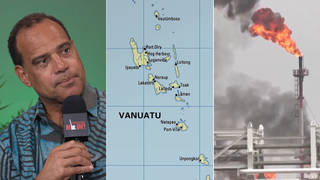
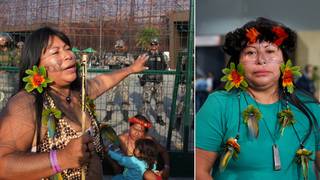
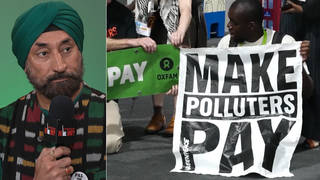
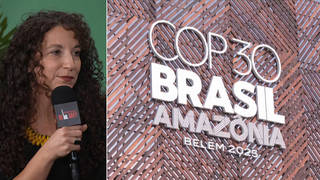





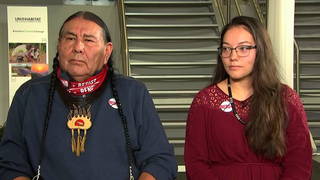
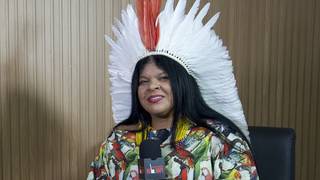
Media Options